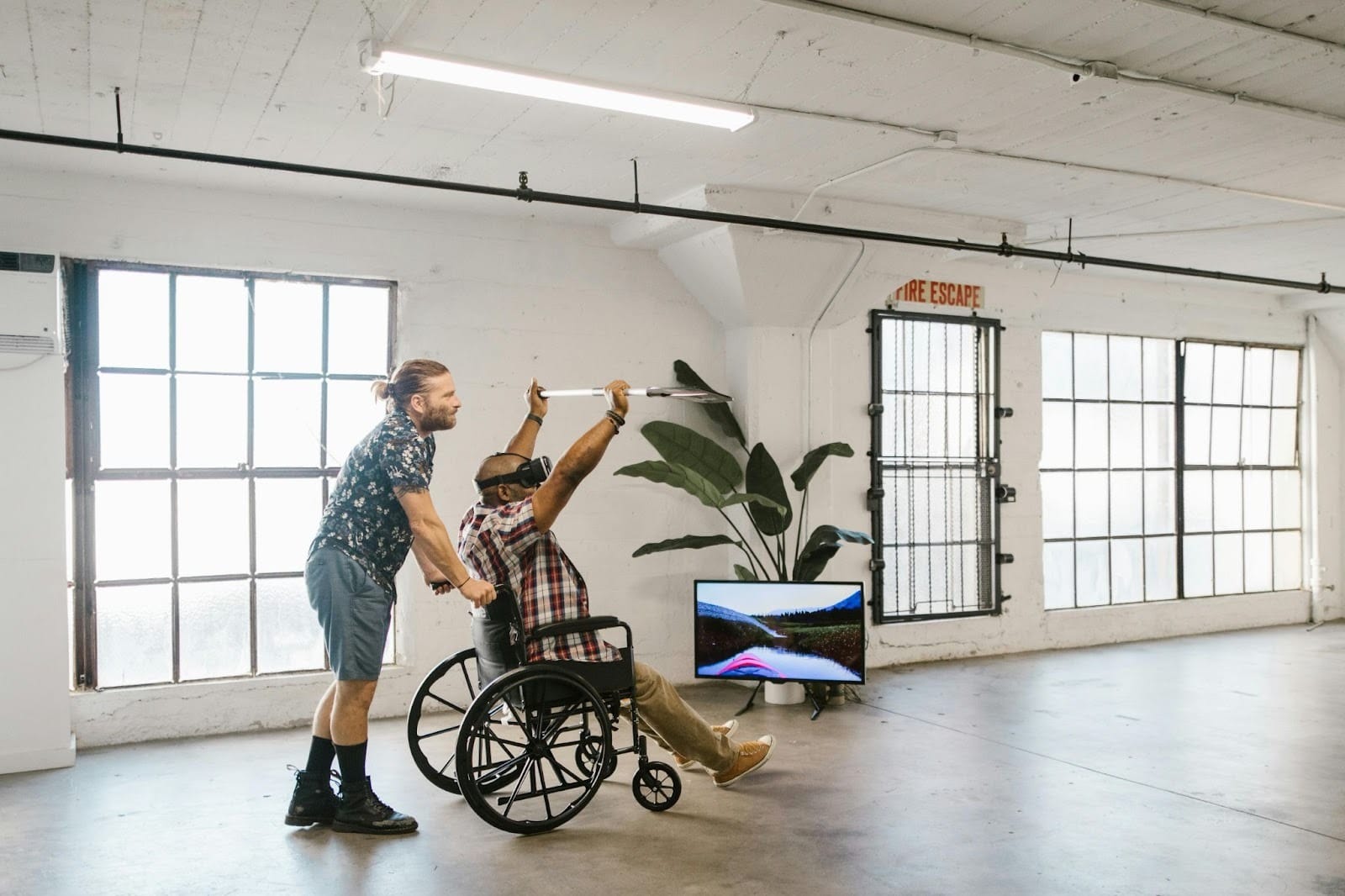Extended Reality in Healthcare: Benefits, Applications & Future of XR in Medicine
Over the past decade, Extended Reality (XR) in healthcare has transformed patient care, medical training, and surgery. XR technologies have empowered surgeons with VR simulations to enhance precision and provided medical students a platform to practice techniques in safe virtual environments.
Beyond the operating room, VR and AR are accelerating stroke rehabilitation by promoting neuroplasticity and faster motor recovery. In pain management, VR offers a safe alternative to opioids to reduce neuropathic pain. For mental health, veterans with PTSD have seen significant symptom improvement with the help of VR therapy. XR is not just enhancing healthcare but rather reshaping the medical future.
What is Extended Reality (XR) in Healthcare?

Alt text: XR applications in healthcare
Extended Reality (XR) in healthcare encompasses immersive technologies such as Virtual Reality (VR), Augmented Reality (AR), and Mixed Reality (MR) that create interactive, three-dimensional environments for medical applications.
Unlike traditional digital health tools like telemedicine or mobile health apps, XR enables real-time, spatial interactions with medical data, enhancing both clinical practice and education.
Key technologies and components in XR healthcare include:
Hardware: Devices such as VR headsets, smart glasses, and AR wearables.
Software: Applications for simulations, diagnostics, and therapy.
Imaging & Sensors: 3D imaging, motion tracking, and biosensors for precise interaction.
Interfaces: Gesture-based and voice-controlled systems for intuitive use.
Notable Examples:
MediView XR: Collaborated with Carle Illinois College of Medicine to integrate the XR90 platform into educational and clinical programs, providing 3D visualization for surgical planning.
GigXR: Partnered with the University of Michigan to utilize holographic content for medical training, enhancing the learning experience for students.
Benefits of Extended Reality in Healthcare
Enhanced Visualization: XR allows for detailed, interactive views of medical data to support accurate diagnostics and plan patient treatment.
Patient-Centric Care: Immersive XR experiences reduce anxiety, improve engagement, and enhance therapeutic outcomes.
Medical Education & Training: Institutions like the University of Nevada have developed XR classrooms that support large-scale immersive learning where students can engage in hands-on, interactive anatomy learning.
Key Applications of Extended Reality in Healthcare

Medical Training and Education
Extended Reality is revolutionizing medical education by enabling students and professionals to learn through realistic, risk-free simulations.
VR-based training platforms like FundamentalVR and Osso VR enable surgeons to practice complex procedures in virtual environments that mimic real-life operating rooms.
Universities such as Stanford Medicine and the University of Michigan have integrated XR into their curriculum. This enabled anatomy learning and procedural skill development without relying solely on cadavers or physical labs.
Patient Treatment and Therapy
XR technologies are improving patient recovery and well-being through immersive, personalized care.
VR-based rehabilitation tools, such as those from MindMaze and XRHealth, assist stroke and trauma patients in regaining motor skills through gamified exercises.
In pain management, VR therapy from companies like AppliedVR helps reduce chronic pain and anxiety by shifting patients' focus away from discomfort.
Mental health programs are also leveraging XR to treat PTSD, phobias, and depression through controlled exposure and guided therapy environments. Companies like Floreo use VR to help individuals with autism develop social skills by simulating real-world scenarios.
Surgical Planning and Assistance
In operating rooms, XR provides surgeons with 3D holographic visualizations of patient anatomy for better precision and decision-making.
Platforms like MediView XR and Microsoft HoloLens 2 enable real-time overlay of medical imaging during surgery, allowing clinicians to "see through" tissue and navigate with accuracy. This reduces risks, shortens procedure times, and improves surgical outcomes.
Remote Consultations and Telemedicine
Extended Reality is extending the capabilities of telemedicine by enabling immersive remote consultations. Using AR headsets and 3D visualization, specialists can guide local clinicians through procedures or examine patients virtually.
Companies such as Proximie are already deploying XR tools that connect surgeons across continents in real time, ensuring expertise is accessible even in remote or under-resourced locations.
Market Trends and Future Growth
According to Grand View Research, the US Augmented Reality, Virtual Reality, and Mixed Reality in healthcare market size is projected to grow at a CAGR of 15.4% from 2025 to 2030.
The global healthcare XR market growth is driven by advancements in AI, 5G, and wearable devices. Hospitals and medical schools are increasingly investing in XR infrastructure for simulation training, patient engagement, and precision medicine.
Challenges and Solutions for XR Adoption in Healthcare
Regulatory and Data Privacy Concerns
Healthcare XR systems handle sensitive patient data, making compliance with privacy regulations like HIPAA and GDPR essential. To address this, developers are implementing secure data encryption and on-device processing to protect patient information and meet regulatory standards.
Cost and Technical Expertise Barriers
High hardware costs and limited technical expertise can hinder widespread adoption, especially in smaller hospitals or developing regions. However, the growing availability of affordable XR headsets and cloud-based training platforms is making implementation more feasible.
Engineering and Software Development Advancements
Recent progress in software development, spatial computing, and motion tracking is facilitating seamless XR integration in clinical workflows. Open platforms are helping ensure XR tools can communicate with existing hospital systems such as electronic health records (EHRs). These engineering advancements are paving the way for scalable, efficient, and secure XR adoption in mainstream healthcare.
Real-World Examples and Case Studies
XR applications in healthcare in the real world are a great example of how immersive technology is transforming every facet of the care industry:
Surgical Planning & Intraoperative Guidance
Extended Reality is transforming surgical precision and planning through Mixed and Augmented Reality visualization.
Surgeons at the Cleveland Clinic and Mayo Clinic use Microsoft HoloLens to overlay 3D anatomical data directly onto patients during surgery, enabling real-time navigation and minimizing invasive exploration.
MediView XR's platform also combines AR with live imaging to guide surgeons through complex procedures such as spinal and breast cancer surgeries.
Medical Education & Training
Medical schools and hospitals are integrating XR-based simulations to train healthcare professionals in a safe, repeatable environment.
GigXR, in partnership with the University of Michigan and Cambridge University Hospitals, delivers holographic training modules for emergency response, neonatal resuscitation, and anatomy visualization.
These immersive simulations enhance retention and confidence among medical students and trainees.
Therapy & Rehabilitation
In rehabilitation settings, XR tools such as MindMaze, SyncThink, and XRHealth help patients recover motor functions after stroke or neurological injury. Clinics and practitioners that have used these systems have reported faster recovery times and higher patient motivation compared to traditional physical therapy.
Mental Health & Behavioral Health
Virtual Reality healthcare therapy is showing promising results in treating mental health disorders such as PTSD, anxiety, and phobias.
The US Department of Veterans Affairs has used VR exposure therapy to help veterans confront and manage trauma, resulting in measurable reductions in PTSD symptoms.
Startups like OxfordVR and Limbix are also delivering immersive mental health programs for anxiety management and behavioral therapy.
Pain Management & Chronic Disease Monitoring
Virtual Reality is emerging as a powerful tool for non-pharmacological pain management.
Platforms like AppliedVR have demonstrated up to 69% reductions in pain intensity during VR sessions and improved emotional well-being post-treatment.
XR systems are being tested for chronic disease monitoring and helping patients visualize their health data in engaging, interactive ways that promote adherence to treatment plans.
Remote Consultations & Telehealth
Extended Reality is expanding access to specialized care through immersive telemedicine solutions.
Using devices like HoloLens 2, oncologists can conduct remote consultations for breast cancer care, guiding local clinicians in real time with holographic visuals.
Companies such as Proximie enable remote surgical assistance, allowing experts worldwide to virtually "scrub in" and support live operations through AR overlays and shared 3D perspectives.
Conclusion
Extended Reality in healthcare is rapidly redefining the medical landscape and bridging the gap between physical and digital medicine. From immersive medical education to precision-guided surgery and virtual therapy, XR is enhancing accuracy, accessibility, and empathy across the care industry.
As XR becomes a driving force in the next wave of digital transformation, it's crucial for healthcare organizations, innovators, and practitioners to stay ahead of the curve. The future of XR in healthcare lies in its ability to create smarter, more connected, and deeply personalized systems of care.